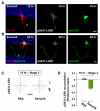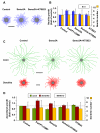Semaphorin3A regulates neuronal polarization by suppressing axon formation and promoting dendrite growth
- PMID: 21835341
- PMCID: PMC3164872
- DOI: 10.1016/j.neuron.2011.06.041
Semaphorin3A regulates neuronal polarization by suppressing axon formation and promoting dendrite growth
Abstract
Semaphorin 3A (Sema3A) is a secreted factor known to guide axon/dendrite growth and neuronal migration. We found that it also acts as a polarizing factor for axon/dendrite development in cultured hippocampal neurons. Exposure of the undifferentiated neurite to localized Sema3A suppressed its differentiation into axon and promoted dendrite formation, resulting in axon formation away from the Sema3A source, and bath application of Sema3A to polarized neurons promoted dendrite growth but suppressed axon growth. Fluorescence resonance energy transfer (FRET) imaging showed that Sema3A elevated the cGMP but reduced cAMP and protein kinase A (PKA) activity, and its axon suppression is attributed to the downregulation of PKA-dependent phosphorylation of axon determinants LKB1 and GSK-3β. Downregulating Sema3A signaling in rat embryonic cortical progenitors via in utero electroporation of siRNAs against the Sema3A receptor neuropilin-1 also resulted in polarization defects in vivo. Thus, Sema3A regulates the earliest step of neuronal morphogenesis by polarizing axon/dendrite formation.
Copyright © 2011 Elsevier Inc. All rights reserved.
Figures






Comment in
-
Semaphorin breaks symmetry.Neuron. 2011 Aug 11;71(3):381-2. doi: 10.1016/j.neuron.2011.07.020. Neuron. 2011. PMID: 21835334 Free PMC article.
Similar articles
-
Local and long-range reciprocal regulation of cAMP and cGMP in axon/dendrite formation.Science. 2010 Jan 29;327(5965):547-52. doi: 10.1126/science.1179735. Science. 2010. PMID: 20110498
-
LKB1/STRAD promotes axon initiation during neuronal polarization.Cell. 2007 May 4;129(3):565-77. doi: 10.1016/j.cell.2007.04.012. Cell. 2007. PMID: 17482549
-
Semaphorin3A accelerates neuronal polarity in vitro and in its absence the orientation of DRG neuronal polarity in vivo is distorted.Mol Cell Neurosci. 2007 Oct;36(2):222-34. doi: 10.1016/j.mcn.2007.07.003. Epub 2007 Jul 24. Mol Cell Neurosci. 2007. PMID: 17728139
-
[Molecular mechanisms of neuronal polarity].Nihon Shinkei Seishin Yakurigaku Zasshi. 2005 Aug;25(4):169-74. Nihon Shinkei Seishin Yakurigaku Zasshi. 2005. PMID: 16190365 Review. Japanese.
-
[Molecular mechanism of axon guidance].Nihon Shinkei Seishin Yakurigaku Zasshi. 2006 Jun;26(3):135-40. Nihon Shinkei Seishin Yakurigaku Zasshi. 2006. PMID: 16866215 Review. Japanese.
Cited by
-
Pathways Controlling Formation and Maintenance of the Osteocyte Dendrite Network.Curr Osteoporos Rep. 2022 Dec;20(6):493-504. doi: 10.1007/s11914-022-00753-8. Epub 2022 Sep 10. Curr Osteoporos Rep. 2022. PMID: 36087214 Free PMC article. Review.
-
Single-cell analysis reveals specific neuronal transition during mouse corticogenesis.Front Cell Dev Biol. 2023 Nov 6;11:1209320. doi: 10.3389/fcell.2023.1209320. eCollection 2023. Front Cell Dev Biol. 2023. PMID: 38020907 Free PMC article.
-
Cyclic Nucleotide Control of Microtubule Dynamics for Axon Guidance.J Neurosci. 2016 May 18;36(20):5636-49. doi: 10.1523/JNEUROSCI.3596-15.2016. J Neurosci. 2016. PMID: 27194341 Free PMC article.
-
Semaphorin signaling in vertebrate neural circuit assembly.Front Mol Neurosci. 2012 Jun 6;5:71. doi: 10.3389/fnmol.2012.00071. eCollection 2012. Front Mol Neurosci. 2012. PMID: 22685427 Free PMC article.
-
The effects of early-life seizures on hippocampal dendrite development and later-life learning and memory.Brain Res Bull. 2014 Apr;103:39-48. doi: 10.1016/j.brainresbull.2013.10.004. Epub 2013 Oct 15. Brain Res Bull. 2014. PMID: 24140049 Free PMC article. Review.
References
-
- Arimura N, Kaibuchi K. Neuronal polarity: from extracellular signals to intracellular mechanisms. Nat. Rev. Neurosci. 2007;8:194–205. - PubMed
-
- Barnes AP, Lilley BN, Pan YA, Plummer LJ, Powell AW, Raines AN, Sanes JR, Polleux F. LKB1 and SAD kinases define a pathway required for the polarization of cortical neurons. Cell. 2007;129:549–563. - PubMed
Publication types
MeSH terms
Substances
Grants and funding
LinkOut - more resources
Full Text Sources

